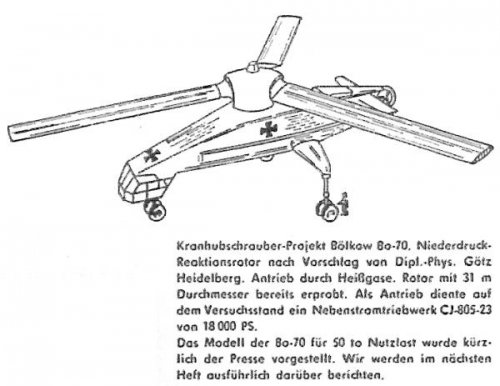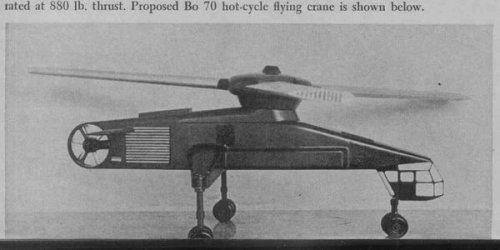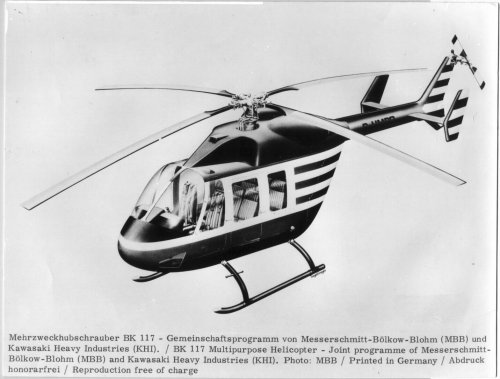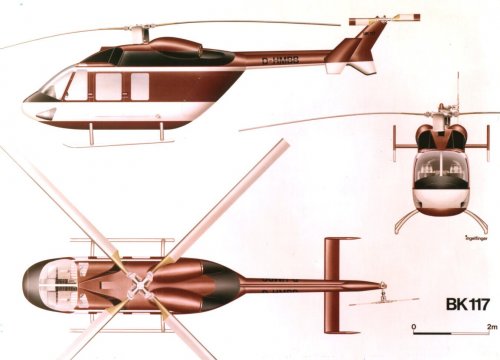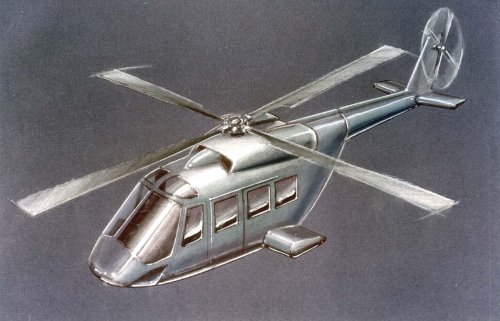Messerschmitt-Bölkow-Blohm Bo 105 Sub-Type Designations [CDN inserted before sub-type designation for MBB Canada-built a/c]
Bo 105 - 4/5 seat light helicopter, twin-engined with rigid main rotor
- Bo 105 V1: 1966, Westland Scout rotor, unflown (destroyed by ground resonance)
- Bo 105 V2: 1967, Bölkow rigid rotor, 2 x Allison 250-C18 turboshafts
- Bo 105 S1 - SB, 1969 pre-production series, 2 x Allison 250 C18
-- aka Bo 105 V4 and V5
- Bo 105A: First production lot, Allison 250 C18, 1970
- Bo 105B: 1967, aka Bo 105 V3, 2 x 280 shp MAN 6022B turboshafts
- Bo 105C: 1971 production model, 2 x Allison 250 C20 turboshafts
--- NBO-105: Indonesian IPTN licenced Bo 105C (rotors/trans supplied by MBB)
-- Bo 105CB: 1976, utility model, Allison 250 C20B, 1976
--- NBO-105 CB: Indonesian equivilent to Bo 105CB, Allison 250 C20B
--- Bo 105CB-4: [used by Chilean AF, others?]
--- HKP-9A: Swedish army Bo 105CB PAH (Saab Emerson HELI-TOW PAL)
-- Bo 105CBS: 1980 Super Five, stretched utility/EMS variant, 250 C20B
--- NBO-105 CBS: Indonesian equivilent to Bo 105 CBS, Allison 250 C20B
--- NBO-105S: IPTN's stretched version of NBO-105 CBS
--- PT.DI Bumblebee-001: [Project] Indonesian attack helicopter based on NBO-105
---- http://www.secretprojects.co.uk/forum/index.php/topic,11639
-- Bo-105CBS-4: Spanish CASA-built 'CBS for Guardia Civil
-- Bo 105CBS-5: Super Five, 1994 high-performance Bo 105CBS variant
--- aka Eurocopter EC-Super Five, 250 C20B, new rotor blades, uprated gearbox
-- Bo 105CS, 1977 Bo 105C SAR variant, Allison 250 C20
--- HKP-9B: Bo 105CBS SAR variant for Swedish AF
- Bo 105D: 1972 offshore version of Bo 105CB, 250 C20B, for UK FR operation
-- Bo 105DB: minor mods for UK certification
-- Bo 105DB-4: [?]
-- Bo 105DBS: stretched EMS version of UK-certified Bo 105D
--- Bo 105DBS-4 and Bo 105DBS-5
-- Bo 105DS: [?]
- Bo 105E-?: [Export?] re-desig. of ex-Bundeswehr Bo 105P for donation [?]
-- Bo 105E-4: 2006 upgraded ex-Bundeswehr Bo 105P donated to Albania
- Bo-105 Executaire: stretched Bo 105C under licence by Boeing Vertol and Carson
- [??] Boeing torpedo-armed Bo-105 proposal for US Navy LAMPS II competition
-- http://www.secretprojects.co.uk/forum/index.php/topic,13139.msg130333.html#msg130333
- Bo 105HGH: 'high-speed helicopter' from V2 prototype, streamlined, then fitted with wings
- Bo 105L, Allison 250 C28C, Bo 105CB with more powerful engine/uprated gearbox
-- Bo 105LS: more powerful (2 x 550 shp/uprated gearbox) version
-- Bo 105LS: Bo 105CBS with more powerful Allison 250 C28C engine
-- Bo 105LS-A1: 1984, stretched, Allison 250-C28C, 1 a/c for Chilean AF
-- Bo 105LS-A2: [Project]
-- Bo 105LS-A3: 1986, hot-and-high Bo-105LS, 2600 kg MTOW, first 10 [?] 'LS-A3 by MBB, remainder by MBB Canada
--- Bo 105LS-A3 offered to Canadian Coast Guard (which took Bo 105 CDN-BS-4s instead)
-- Bo 105LS-B1: Bo-105LS prototype re-engined with twin P&WC PW2OSB turboshafts (intended for CFLH requirement)
--- Bo 105LS-B1: 1988, one a/c built and tested in Canada (C-FMCL)
-- Bo 105LS-AR: Super Lifter, 1995, Allison 250 C28C, new MR blades (conv. of existing 'LS)
- Bo 105M, Allison 250 C20B, 1978, VBH for Bundeswehr Heeresflieger
--- VBH = Verbindungs und Beobachtungs Hubschrauber ('connection' or scout)
-- aka HE.15 (Helicóptero Escuela) Spanish military training helicopter
--- Bo-105GSH: Spanish light anti-tank helicopter, equivalent to Bo 105M/VBH
--- aka Bo 105LOH/HR.15 (Helicóptero de Reconocimiento), 14 for Spanish Army
--- HR.15, opt. twin 7.62mm machinegun armament (but likely never fitted)
-- Bo 105[?]: [Project] BSH 1 (Begleitschuetz Hubschrauber) escort helicopter
--- BSH 1: 54 Bo-105M/VBH selected for conv. with Stinger AAM, cancelled 1993
-- Bo 105MSS: Maritime Surface Search, Bo 105M fitted with search radar
- Bo 105P, Allison 250 C20B, 1979, anti-tank a/c for Bundeswehr Heeresflieger
-- aka PAH 1 (Panzerabwehrhubschrauber), BW designation, 6 x HOT ATGM tubes
-- Bo 105ATH: Spanish equivalent to Bo 105P/PAH-1 light anti-tank helicopter
--- aka HA.15 (Helicóptero Asalto), 28 for Spanish Army, 6 x HOT missiles
-- Bo 105P1: 1991 PAH 1 upgrade (x 155 with HOT 2), aka PAH 1A1/PAH 1 Phase 1
-- Bo 105P2: [Project] PAH 1A2/PAH 1 Phase 2 night attack version, canc. Jan 1993
-- Bo 105/OPHELIA: 1981 test and trials a/c fitted with mast-mounted sight
--- aka 'Giraffe', OPHELIA = Optique Platform HELIcoptere Allemande
- Bo-105SC: 10 x Philippine-assembled Bo 105C for PADC [? confirm desig. ?]

